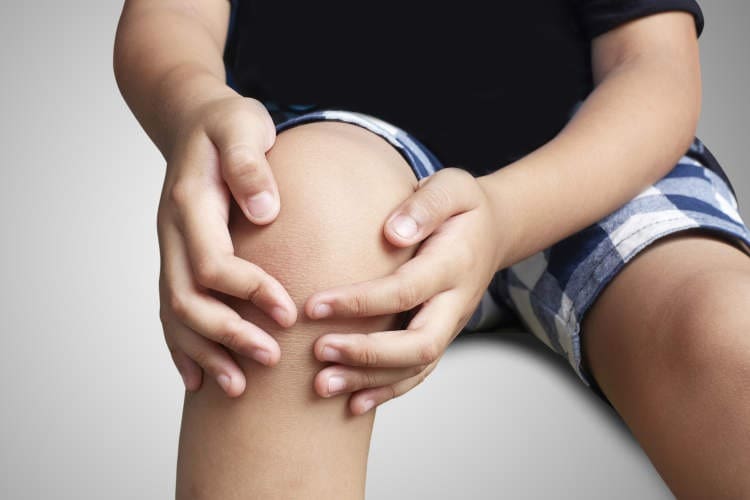Osgood-Schlatter disease is a common condition that affects children and teenagers when they are having a growth spurt. The main symptom is pain in the shin bone just below the knee. Children who participate in sports and activities that require a lot of running or jumping are particularly prone to this condition.
Self-care treatments to reduce symptoms are usually all that’s needed. Osgood-Schlatter disease is a temporary condition that should get better on its own once your child stops growing.
What are the symptoms?
The main symptoms of Osgood-Schlatter disease are pain and swelling at the front of the tibia (shin bone), just below the knee cap. The pain usually comes on gradually. There may be a bony bump at the front of the tibia that’s tender to touch.
The pain is usually most obvious during (or just after) activities such as running, jumping, kneeling and climbing stairs. It tends to improve with rest. Usually only one knee is affected, but both knees are affected in about 20-30 per cent of cases.
The pain and discomfort of Osgood-Schlatter disease may last for weeks or months, but may come back again while your child is still growing.
Causes
Osgood-Schlatter disease is caused by the pulling forces that the thigh muscles exert on the rapidly growing shin bones, especially in children and teenagers who are very active.
The powerful quadriceps muscle of the thigh is attached (by its tendon) to the front of the shin bone, just below the knee cap. This part of the bone is called the tibial tuberosity, which is very near the growth plate where new bone is being formed. The tibial tuberosity seems to be less able to withstand the pulling forces from the quadriceps during a growth spurt. This may lead to inflammation and minor fragmentations of the bone or cartilage, resulting in pain and swelling just below the knee cap.
Risk factors
Girls are most often affected between the ages of 8 and 12 years, while boys tend to have this problem between 12 and 15 years of age. The difference reflects the fact that girls tend to start puberty and have their growth spurt earlier than boys.
Osgood-Schlatter disease tends to affect boys more than girls, but the gap is narrowing due to an increase in the number of girls participating in sports.
Sports and activities that tend to put kids and teens at increased risk include those that involve lots of running, jumping and quick changes of direction, such as soccer, netball, basketball and ballet.
Tests and diagnosis
If your child is complaining of a persistent sore knee or painful area just below the knee, take them to see your GP (general practitioner). They will ask about the knee pain and what tends to make it worse or better. They will also examine your child’s legs.
A diagnosis of Osgood-Schlatter disease can usually be made based on the symptoms and examination findings. In some cases, especially if the diagnosis is in doubt, your doctor may recommend having an X-ray or ultrasound scan of the knee area.
Treatment of Osgood-Schlatter disease
The main treatments are simple self-care measures to help relieve the pain and discomfort. Stretching and strengthening of the leg muscles can also help improve symptoms.
Self-care measures
Reducing or modifying sports and activities that aggravate the pain is usually recommended to ease symptoms. It’s not usually necessary to stop sport completely – limiting activities is often enough. It may be necessary for your child to avoid activities that cause significant pain for a few weeks and then gradually return, based on their symptoms.
Your child may want to consider changing to sports that don’t involve as much running and jumping (swimming or water polo) while they are experiencing symptoms.
Support bandaging or taping can help reduce pain during sports and other activities by distributing some of the pulling force away from the shin bone. Applying an ice pack for 20 minutes after activities is also helpful.
Physiotherapy
A physiotherapist can recommend stretching and strengthening exercises for your child. They can also show you how to strap or bandage the knee to reduce pain.
Stretching of the thigh muscles (quadriceps and hamstrings) can be helpful because having tight quadriceps can increase the pulling force on the growth plate in the tibia.
| How to do a quadriceps stretch | |
|---|---|
 |
To stretch your quads, stand next to a wall or doorway and hold on with one hand to keep your balance. Lift one foot off the ground, bending your knee so that you can hold the ankle with your other hand.
Pull the ankle gently up and back so that you can feel the quadriceps muscle (at the front of the thigh) stretching. Repeat for the opposite leg. Your doctor or physiotherapist can show your child how to do this if you are not sure. |
Osgood-Schlatter disease usually resolves once your child has stopped growing. In some cases, the bony lump remains, which may cause pain and tenderness when kneeling. If the pain is persistent and troublesome, surgery may be recommended, but this is rare.

